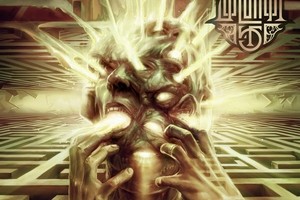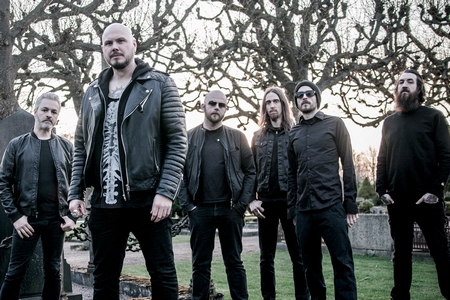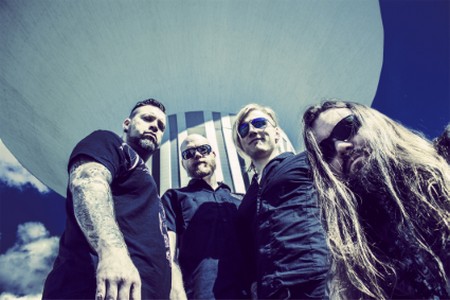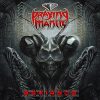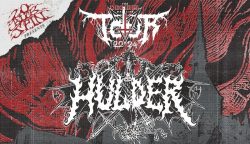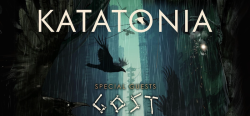Solution .45 – Awakened from a Nightmare State
Sunday, 28th August 2016
So the saying goes, there’s always the calm before the storm. In the case of Solution .45, there was plenty of calm in the five years between their debut, For Aeons Past, and the release of Nightmares in the Waking State Part I last November. But that ushered in the storm, as Part II has just been released – giving fans two albums within the span of a year.
A double-album, Nightmares in the Waking State was all written, recorded, and mixed at the same time and then split apart into two separate releases. A move that differed from the majority of the crowd, as double and even triple albums has become more commonplace in recent years. We once again grabbed the ear of guitarist Jani Stefanovic to talk more about how the two halves compare, his thoughts on double albums, and where the band goes from here.
Dead Rhetoric: Listening to both part I and part II, do you feel that II is a little more melodic overall?
Jani Stefanovic: I heard that from several people after they heard the two [songs from Part II] – the lyric video and the music video. People seemed to say that Part II, so far, seemed to be more straight-forward and more melodic. Before that, I didn’t really reflect on it. We tried to get both albums to be as dynamic and as diverse as possible, so there wouldn’t be this obvious difference between the two parts. And not in the sense that Part I is the best part or Part II is the leftovers. We didn’t want to give the feeling that they are too different – but it might be so…not intentionally, but it might be so just by accident that Part II is so melodic. I don’t feel so – I think both parts have the progressive, atmospheric structured songs and the more straight-forward songs on there. I’ll leave it up to the listeners – if you feel that way, then there’s no wrong in feeling that way.
Dead Rhetoric: You mentioned about how you were balancing the albums – how much time was spent time trying to make sure that the albums were both balanced and equitable?
Stefanovic: It was mostly Christian [Älvestam]’s efforts. He was the one who wrote the lyrics and he had more intel on what everything was about. He was the one who sort of tried out different tracklists before he presented his ideas to us. I sort of left that to him because he is quite good at that, so we listened through the track orders he presented, chewed on it for a few days, and changed a few things. It didn’t take too long, but we tried a few options.
Dead Rhetoric: Other than it being all recorded at once, are there any significant ties between the two halves, either musically or lyrically?
Stefanovic: More so the lyrics in that case. You have 19 tracks and one instrumental, and musically you have a broad spectrum of songs – very intense to softer. The lyrical aspect is more consistent, which evolves around the same core issues in both parts. That’s why we divided them into two parts, released separately, but it’s actually one album. We just chose to make it into two parts. It could have been that you had both parts from the very start, and you would have had one giant piece of music, with the same lyrical context. We tried to make them consistent, like I said, so that each part could stand on its own feet and not be any lesser than the other part. Opinions might be different [laughs], but that was our goal – for both to be strong individual releases, but an awesome experience when you have both parts that you can listen to.
Dead Rhetoric: Now that Part II is nearly released, do you feel that most people understand that both albums were recorded at the same time?
Stefanovic: I think people will get it by listening – the soundscape is exactly the same. Those who complained about the vocals being too low will unfortunately be disappointed again because everything was mixed at the same time. I think most will understand that everything was done at the same time.
Dead Rhetoric: Do you think that the release of Part I has helped gain momentum for fans to hear the rest?
Stefanovic: We feel that it worked as we intended it to. To build the expectation and anticipation – there’s more to come. I think those who really follow us were excited and have been excited that there was more to come, and not this distant, “yeah, they will make a new record [eventually].”
Dead Rhetoric: Going back to the comments about the vocal mix, do you feel there was anything negative about releasing half of the material and then having to sit on the rest for a while?
Stefanovic: We never brought up the question of re-doing something, but when you get a distance from the things you have done, you can always return and come up with things you can do differently. Of course, we have things that we could or want to do differently, but at the end of the day, we are still really happy with the end result and the overall feeling of both albums. It was a really big task to keep track of everything that needed to be done, and time-wise with the tracks. One thing that we took with us would be not to do another double-album anytime soon [laughs]. It was a big effort and time-consuming, but overall we are more than happy with the end result. Of course, we could have made the vocals higher, or not…some like it and can enjoy it, and some people are getting frustrated with that. It’s still a very satisfying album – nothing much to complain about thankfully.
Dead Rhetoric: So, if you were given a chance to go back, would you still release them independently or would you combine them into a true double-album?
Stefanovic: I think based on the reactions we got from Part I – there were a lot of shocked reactions: it sounded so different, or it wasn’t as strong as the first album, or the production was better last time. So I think it was the wisest move to make [releasing them separately]. It would have been too much to digest at once, after being away for 5 years off the radar, and then give two hours of music. It does have a different touch than the debut. We did intentionally walk towards a new direction. We wanted it to be heavier and more brutal, towards our roots. We all have a past in the heavier stuff, so it was a move we did on purpose and we knew that there would be some reactions like that. The ones that love only the clean vocals or need them on each song – we knew they would be disappointed.
We released a video for a full harsh-vocals song first, on purpose, in order to stir up these emotions. We refuse, sort of, to be put into that box. That you can expect this type of song from us, with always clean vocals in the chorus, or there is always this dual-vocal thing. We did quite a few moves on purpose, to give ourselves the freedom to do whatever we want. Doing full-growl songs gives us the option to do full-clean or full-growl songs, or split them. There will not be this pattern that there will always be the “hit” chorus that is clean and silky. That was one of Christian’s wishes that he wanted to walk away from that. He didn’t like that people had those sort of expectations.
Dead Rhetoric: I agree with splitting them up as well – putting it all out there at once, it would have been way too much to digest.
Stefanovic: Personally, there are a lot of bands that have done these double/triple albums, and it’s just too much. Even if the band is amazing and it’s awesome music, you just get overfed. Even if I love the band in question, I have to take a break and listen to something else, or not listen to anything – just take it all in. You sort of get numbed by the information – it’s too much. Until you know the album is good enough that it’s not exhausting anymore. It’s a fun concept, and people like value for their money – everything gets bigger and bigger. I think you get more out of it if it is kept at a decent length.
Dead Rhetoric: Do you have some double-albums that you enjoy?
Stefanovic: I listened to Periphery when they did Alpha and Omega, and it almost always fell into not listening to both of them. I only got through the first part, or I skipped Alpha and went to Omega the next time. The same thing with Soilwork’s The Living Infinite. Pretty good songs but I never listen through the whole album at once – I always came halfway and thought it was too much. Like I said, I like the bands and enjoy their music, but it gets to be too much. The same thing when Dream Theater released live albums back in the day with three discs or something. Even if I knew all the music and loved the songs – Falling into Infinity and the Awake-era, that’s how I work at least.
Dead Rhetoric: The landscape has shifted between 2010 and today, in regards to the reception of melodic death metal. Have you found that a lot of old fans have made their way back following the last album?
Stefanovic: I don’t really know, because a few years before the album was to be recorded, it felt like we had a steady and strong fanbase on Facebook. It’s not much, but I think it’s a decent amount for a band that did nothing for 5 years. We had almost 20,000 followers who wrote there and did anticipate things, so to us it seemed like we still have this really committed fans that really wait for something new. Like I said in the previous interview for Part I, it was never the intention of being 5 years but stuff just happened. So we are glad that everyone stuck around!
Dead Rhetoric: With the band involved with families and an overall lack of time, what do you feel is one thing that people don’t give band members enough credit for when there is a long wait in between albums?
Stefanovic: I usually don’t reflect so much – we just do the stuff that we do and enjoy it. I read comments and I want to be up-to-date on what people are listening to and what they are saying about different bands, but at the same time, I don’t let any of those kind of things affect the creative process in anyway. I don’t write music to please someone else; it has to please us first. I don’t mind if I don’t get the credit either. I would still write music if it wasn’t even released. I would still do the same stuff. I actually have a lot of music stored on my computer that has never been released. I would love for them to be released, but there just hasn’t been time for it.
I do a lot of things, even if no one hears them, but I enjoy it just as much. I personally get a kick out of it when I write something I like. “This was crazy good – this part on this song was so good.” I can be happy at that stage, even if no one else, other than my wife, has heard it. Of course, it makes me happy when someone else out there, no matter where they are, likes it. You feel fortunate that there are actually people out there who want to hear what I make in my little private studio. In the end, its about getting your ideas out there. It’s a kid who’s having a blast – this is my passion. Regardless of feedback or credit, I think my day would look the same, despite everything else.
Dead Rhetoric: As a band that is less focused on touring, where you can make some money off of merch sales, what is your take on streaming services such as Spotify?
Stefanovic: I’m actually a bit torn about that. In one way, I think YouTube and these streaming sites are a good tool, but it depends on what angle you have on it. If you look at it in terms of who is making the money, it’s a really bad deal for the musicians – signed to a label with not such a good deal. Many bands made their deals before Spotify, and Spotify came along and you don’t have anything in your deal about it and the label is taking the money with the band getting almost nothing. I’ve heard similar stories about that. I have no idea about how they distribute shares, but out of personal experience, I haven’t seen a lot [laughs]. In that sense it sucks, but I have never done this with the focus of making money. Personally, I use Spotify and I check on YouTube for music, so I’m as guilty as anybody. So it really depends on the angle you want to look at, but overall it’s a very convenient way [to hear music].
But I think it’s a shame that everything has gone to this streaming quality mp3, where everyone settles for this low-quality [sound]. Bands spend hours and hours mixing on analog consoles and getting the best sound, and then you strip away one third of the information that is found on the vinyl or the CD. If you want to go into the technical parts, it’s really a shame that everything has gone to this digital streaming. But everyone uses them anyways so I don’t know.
Dead Rhetoric: The videos are done, the second album is almost ready to come out. What’s next now for Solution .45?
Stefanovic: We have been working hard with our booking agency to work on some tour dates for us. We have gotten some decent offers for Europe, but nothing for the States at the moment. We would love to get over [to the States] and play, but a lot needs to happen before that – we also need to tag along with a bigger band at this point. Hopefully we will get something good going on in Europe – we wanted to wait until both albums were released. We have 2-3 hours of material that we can pick from and get a decent live set going on. So I’m not promising anything, but everything is planned for 2017. Hopefully something will work out once Part II comes out and we’ll get some more media attention and venues will be more interested in having us. We know the fans would want us, but it’s always about money and everything else. We definitely want to change the perspective about not being a live band, so let’s hope for the best!












